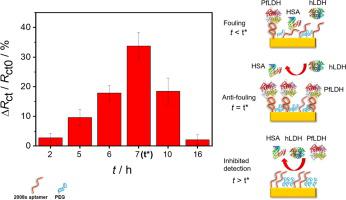Bioelectrochemistry ( IF 5 ) Pub Date : 2020-07-03 , DOI: 10.1016/j.bioelechem.2020.107589 Gabriela Figueroa-Miranda 1 , Changtong Wu 2 , Yuting Zhang 2 , Lena Nörbel 2 , Young Lo 3 , Julian Alexander Tanner 3 , Lothar Elling 4 , Andreas Offenhäusser 2 , Dirk Mayer 2

|
Better approaches are critically needed for in situ point-of-care diagnostic biosensors that enable primary care physicians, or even individual patients, to directly analyze biological fluids without complicated sample pretreatments. Additional purification steps consume time, consume reagents, often require other equipment, and can introduce false-negative results. Biosensors have been modified with blocking molecules to reduce biofouling; however, the effectiveness relies on their chemical composition and morphology. Here, we used a polyethylene glycol film to suppress unspecific binding from human serum on an electrochemical malaria aptasensor. A detailed study of the variation of the chemical and morphological composition of the aptamer/polyethylene glycol mixed monolayer as a function of incubation time was conducted. Higher resistance to matrix biofouling was found for polyethylene glycol than for hydrophobic alkanethiol films. The best sensor performance was observed for intermediate polyethylene glycol immobilization times. With prolonged incubation, phase separation of aptamer, and polyethylene glycol molecules locally increased the aptamer density and thereby diminished the analyte binding capability. Remarkably, polyethylene glycols do not affect the aptasensor sensitivity but enhance the complex matrix tolerance, the dynamic range, and the limit of detection. Careful tuning of the blocking molecule immobilization is crucial to achieving high aptasensor performance and biofouling resistance.
中文翻译:

聚乙二醇介导的用于人类血清中疟疾生物标志物检测的电化学适体传感器的阻滞和单层形态。
现场迫切需要更好的方法即时医疗诊断生物传感器,使初级保健医生甚至个人患者可以直接分析生物体液,而无需进行复杂的样品预处理。额外的纯化步骤会浪费时间,消耗试剂,经常需要其他设备,并且可能导致假阴性结果。生物传感器已通过封闭分子进行了修饰,以减少生物污染;然而,有效性取决于它们的化学组成和形态。在这里,我们使用了聚乙二醇薄膜来抑制人类血清对电化学疟疾适体传感器的非特异性结合。对适体/聚乙二醇混合单层的化学和形态组成随潜伏时间的变化进行了详细研究。发现聚乙二醇对疏水性烷硫醇薄膜具有更高的对基质生物污染的抵抗力。对于中间的聚乙二醇固定时间,观察到最佳的传感器性能。随着长时间的孵育,适体和聚乙二醇分子的相分离局部增加了适体的密度,从而降低了分析物的结合能力。值得注意的是,聚乙二醇不会影响适体传感器的灵敏度,但会提高复杂的基质耐受性,动态范围和检测极限。仔细调整封闭分子的固定性对于获得高适体传感器性能和抗生物污垢性至关重要。适体的相分离和聚乙二醇分子局部增加了适体的密度,从而降低了分析物的结合能力。值得注意的是,聚乙二醇不会影响适体传感器的灵敏度,但会提高复杂的基质耐受性,动态范围和检测极限。仔细调整封闭分子的固定性对于获得高适体传感器性能和抗生物污垢性至关重要。适体的相分离和聚乙二醇分子局部增加了适体的密度,从而降低了分析物的结合能力。值得注意的是,聚乙二醇不会影响aptasensor的灵敏度,但会提高复杂基质的耐受性,动态范围和检测极限。仔细调整封闭分子的固定性对于获得高适体传感器性能和抗生物污垢性至关重要。



























 京公网安备 11010802027423号
京公网安备 11010802027423号